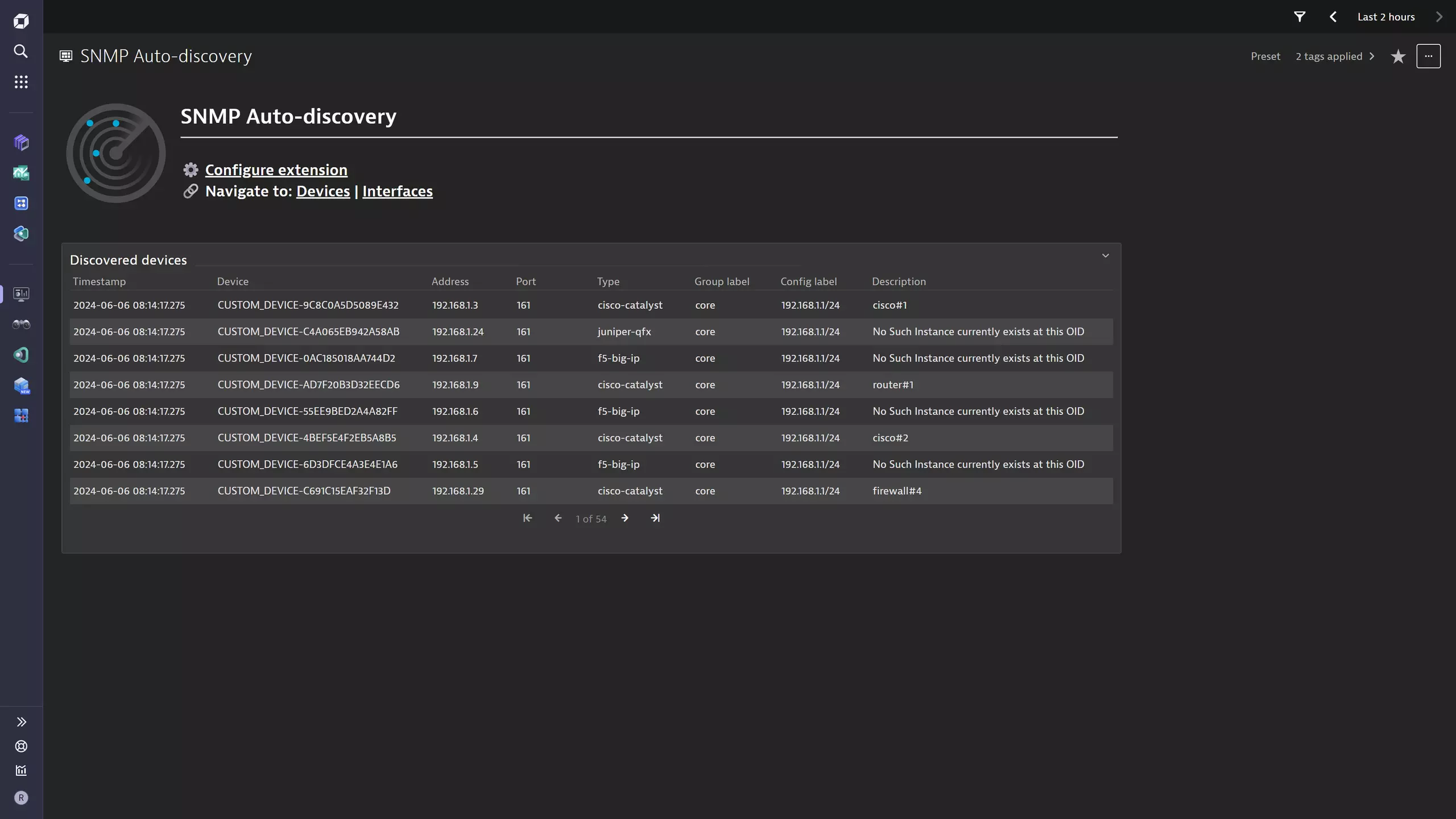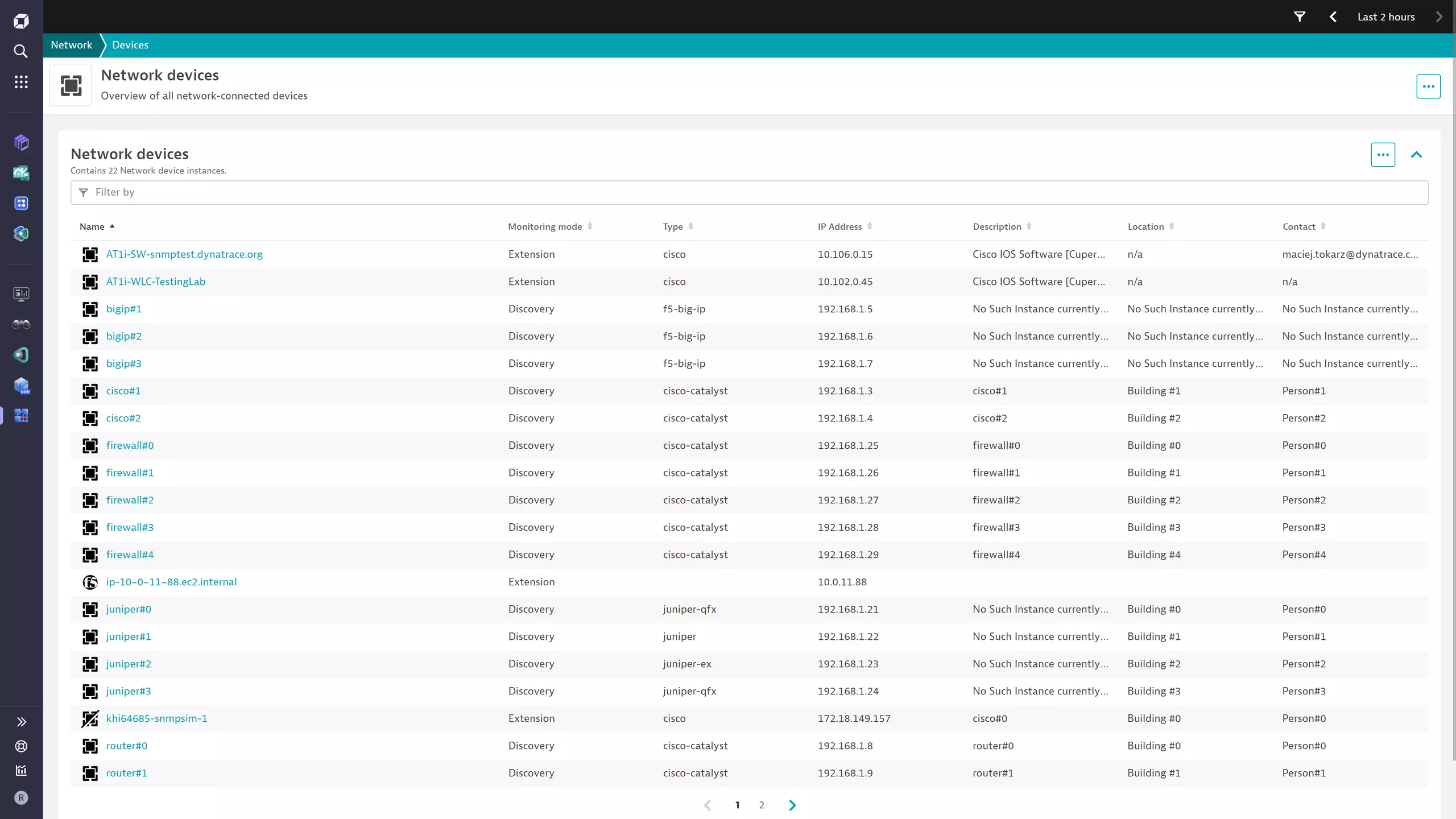SNMP Autodiscovery extension
- Latest Dynatrace
- Extension
- Published Oct 27, 2025
Scan through your subnets and build an inventory of SNMP-enabled network devices.
Discover SNMP-enabled network devices and report them as entities.
Get started
Overview
This ActiveGate extension takes subnets and ranges of IP addresses along with SNMP credentials and scans through them to discover SNMP-enabled network devices. The devices are then reported as entities acting as an entry point to specialized extension configurations.



Use cases
- Simplify the onboarding of network device monitoring in Dynatrace.
- Build an inventory of SNMP-enabled network devices.
- Get a single-pane-of-glass view over all network devices, regardless of technology.
- Find out which Dynatrace Extension can best monitor each device.
- Access all extension network data in one place.
- Understand which extensions Dynatrace recommends for further monitoring and insights.
- Enable the use of
 Discovery & Coverage to automatically set up network monitors and extension configurations for the discovered devices.
Discovery & Coverage to automatically set up network monitors and extension configurations for the discovered devices. - Understand your extended network in terms of device-to-device connectivity, along with port and interface details.
Requirements
- Optional The LLDP protocol must be correctly configured on neighboring devices.
- You have created a monitoring configuration as described in Activation.
- An API access token with the
entities.readandmetrics.readscopes. This is required to enable additional processing of the ingested data. - The API routing module (
restInterface) needs to be enabled on the ActiveGate.
Compatibility information
-
ActiveGate version 1.280+
-
Dynatrace version 1.280+
-
SNMP v2c or v3. For supported parameters, see SNMP data source.
-
Currently, only devices monitored by the following extensions are part of the topology:
Activation and setup
To enable the extension, find SNMP Autodiscovery in the Dynatrace Hub.
Once activated in your environment, you need to create a monitoring configuration with the following parameters:
-
One or more discovery groups. Each group consists of:
-
Network segment: A name or label to indicate the subnet or network segment of which these devices are part.
-
One or more IPv4 or IPv6 configurations. Addresses can be:
-
A range, such as
10.0.0.0-10.0.2.0. -
A subnet in CIDR notation, such as
10.0.20.0/24.Individual addresses may be added with a prefix length of
24or32.
-
-
The port for the SNMP connection.
-
The SNMP credentials:
- SNMP version.
- Specific credentials based on the version.
-
Timeout. Optional How long to wait for an SNMP response before abandoning a device. The default is 1 second. It is recommended to only modify this value if you're experiencing unnecessary timeout issues.
-
-
Discovery mechanism behavior:
- Scanning frequency: How frequently the scan runs, in minutes.
- Performance profile: Based on the performance profile of the ActiveGate. For more information, see About Extensions.
- API token: An access token with
entities.readandmetrics.readscopes. This enables additional processing of the ingested data. - Neighbor discovery: When enabled, discovered devices are also queried for network neighbors, via LLDP.
-
Description: Required The name that appears as an attribute on the discovered devices.
Details
Once configured, the extension executes a simple snmpget request to any configured address and aims to extract six OIDs.
These are then ingested as a log record.
1.3.6.1.2.1.1.5: sysName1.3.6.1.2.1.1.1: sysDescr1.3.6.1.2.1.1.2: sysObjectId1.3.6.1.2.1.1.4: sysContact1.3.6.1.2.1.1.6: sysLocation1.0.8802.1.1.2.1.3.2: lldpLocChassisId
In addition, the extension packages a topology and metrics model that brings together all network devices. It maps them to available extensions that can get deeper insights into the health and performance of that specific technology.
When neighbor discovery is enabled, discovered devices are also queried for network neighbors. This feature relies on the LLDP protocol and this must be correctly configured on the neighbor device to advertise accurate data. With all details correctly advertised, the data produced allows you to see which neighbor device is connected to which queried device and on which port/interface the connection is established.
Licensing and cost
Usage is subject to standard license consumption and charges based on your subscription model.
- Device discovery produces one log record per discovered device every 10 minutes.
- Neighbor discovery produces one log record per neighbor device address every 10 minutes.
Feature sets
When activating your extension using monitoring configuration, you can limit monitoring to one of the feature sets. To work properly the extension has to collect at least one metric after the activation.
In highly segmented networks, feature sets can reflect the segments of your environment. Then, when you create a monitoring configuration, you can select a feature set and a corresponding ActiveGate group that can connect to this particular segment.
All metrics that aren't categorized into any feature set are considered to be the default and are always reported.
A metric inherits the feature set of a subgroup, which in turn inherits the feature set of a group. Also, the feature set defined on the metric level overrides the feature set defined on the subgroup level, which in turn overrides the feature set defined on the group level.
self-monitoring
| Metric name | Metric key | Description |
|---|---|---|
| Devices OK | sfm.snmp_autodiscovery.devices_ok | The amount of addresses that responded to the scanner query as part of a given configuration. |
| Devices scanned | sfm.snmp_autodiscovery.devices_scanned | The total amount of addresses that were scanned by the extension as part of a given configuration. |
| Scan duration | sfm.snmp_autodiscovery.scan_duration | The time the extension took to scan through all addresses that are part of a given configuration. |
FAQ and troubleshooting
The extension reports high CPU usage, what can I do?
ActiveGates can be configured with several levels of resource utilization limits, called performance profiles. By default, more restrictive limits are applied. Whenever you plan to scan over more than 1000 IP addresses, it is recommended that you configure your ActiveGate to use the High limits profile. With particularly large setups, the Dedicated profile allows the extension to leverage even more of the ActiveGate's resources.
To enable the High limits profile on an ActiveGate:
- Go to Deployment Status.
- Find your ActiveGate, expand the row, and select on Settings.
- In the Extension Execution Controller tab, use the drop-down menu to select a different profile.
To enable the Dedicated profile, see Dedicated performance profile configuration.
Leave the restInterface option enabled.
What performance is expected from this extension?
During its execution, the extension will limit resource utilization based on the ActiveGate performance profile.
- Default: 5% CPU and 500 MB memory
- High limits: 15% CPU and 700 MB memory
- Dedicated limits: 30% CPU and 1500 MB memory
High limits profile:
| Load (IPs) | Time (S) | Time (M) | Time (L) |
|---|---|---|---|
| 10,000 | 45 sec | 42 sec | 41 sec |
| 30,000 | 5.3 min | 3.1 min | 2.2 min |
| 100,000 | 20.7 min | 11.1 min | 7.6 min |
| 200,000 | 42.6 min | 22.3 min | 15.2 min |
| 250,000 | 55 min | 27 min | 19 min |
Dedicated limits profile:
| Load (IPs) | Time (S) | Time (M) | Time (L) |
|---|---|---|---|
| 250,000 | 28.5 min. | 19 min | 18.4 min |
To understand expected load and execution times, stress tests were conducted based on our recommended ActiveGate sizing.
- S: c7i.large
- M: c7i.xlarge
- L: c7i.2xlarge
My monitored devices still appear unmonitored. How do I fix this?
To reduce the load on the scanner, but also allow monitored data to take priority, the extension requires an API token with the entities.read and metrics.read scopes.
Also, ensure that the API routing module (restInterface) is enabled on the ActiveGate (even on a Dedicated profile).
Our specialized extensions are being updated to adopt the new network entity model. For information about the devices monitored by extension, see Compatibility information.
